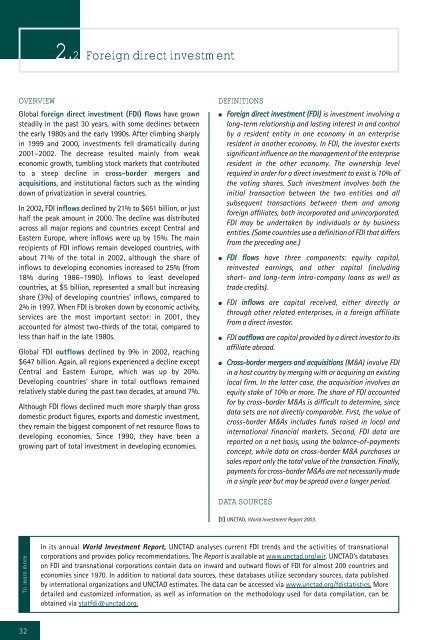Development and Globalization: - Unctad
Development and Globalization: - Unctad
Development and Globalization: - Unctad
Create successful ePaper yourself
Turn your PDF publications into a flip-book with our unique Google optimized e-Paper software.
OVERVIEW DEFINITIONS<br />
Global foreign direct investment (FDI) flows have grown<br />
steadily in the past 30 years, with some declines between<br />
the early 1980s <strong>and</strong> the early 1990s. After climbing sharply<br />
in 1999 <strong>and</strong> 2000, investments fell dramatically during<br />
2001–2002. The decrease resulted mainly from weak<br />
economic growth, tumbling stock markets that contributed<br />
to a steep decline in cross-border mergers <strong>and</strong><br />
acquisitions, <strong>and</strong> institutional factors such as the winding<br />
down of privatization in several countries.<br />
In 2002, FDI inflows declined by 21% to $651 billion, or just<br />
half the peak amount in 2000. The decline was distributed<br />
across all major regions <strong>and</strong> countries except Central <strong>and</strong><br />
Eastern Europe, where inflows were up by 15%. The main<br />
recipients of FDI inflows remain developed countries, with<br />
about 71% of the total in 2002, although the share of<br />
inflows to developing economies increased to 25% (from<br />
18% during 1986–1990). Inflows to least developed<br />
countries, at $5 billion, represented a small but increasing<br />
share (3%) of developing countries’ inflows, compared to<br />
2% in 1997. When FDI is broken down by economic activity,<br />
services are the most important sector: in 2001, they<br />
accounted for almost two-thirds of the total, compared to<br />
less than half in the late 1980s.<br />
Global FDI outflows declined by 9% in 2002, reaching<br />
$647 billion. Again, all regions experienced a decline except<br />
Central <strong>and</strong> Eastern Europe, which was up by 20%.<br />
Developing countries’ share in total outflows remained<br />
relatively stable during the past two decades, at around 7%.<br />
Although FDI flows declined much more sharply than gross<br />
domestic product figures, exports <strong>and</strong> domestic investment,<br />
they remain the biggest component of net resource flows to<br />
developing economies. Since 1990, they have been a<br />
growing part of total investment in developing economies.<br />
To learn more<br />
32<br />
2.2 Foreign direct investment<br />
● Foreign direct investment (FDI) is investment involving a<br />
long-term relationship <strong>and</strong> lasting interest in <strong>and</strong> control<br />
by a resident entity in one economy in an enterprise<br />
resident in another economy. In FDI, the investor exerts<br />
significant influence on the management of the enterprise<br />
resident in the other economy. The ownership level<br />
required in order for a direct investment to exist is 10% of<br />
the voting shares. Such investment involves both the<br />
initial transaction between the two entities <strong>and</strong> all<br />
subsequent transactions between them <strong>and</strong> among<br />
foreign affiliates, both incorporated <strong>and</strong> unincorporated.<br />
FDI may be undertaken by individuals or by business<br />
entities. (Some countries use a definition of FDI that differs<br />
from the preceding one.)<br />
● FDI flows have three components: equity capital,<br />
reinvested earnings, <strong>and</strong> other capital (including<br />
short- <strong>and</strong> long-term intra-company loans as well as<br />
trade credits).<br />
● FDI inflows are capital received, either directly or<br />
through other related enterprises, in a foreign affiliate<br />
from a direct investor.<br />
● FDI outflows are capital provided by a direct investor to its<br />
affiliate abroad.<br />
● Cross-border mergers <strong>and</strong> acquisitions (M&A) involve FDI<br />
in a host country by merging with or acquiring an existing<br />
local firm. In the latter case, the acquisition involves an<br />
equity stake of 10% or more. The share of FDI accounted<br />
for by cross-border M&As is difficult to determine, since<br />
data sets are not directly comparable. First, the value of<br />
cross-border M&As includes funds raised in local <strong>and</strong><br />
international financial markets. Second, FDI data are<br />
reported on a net basis, using the balance-of-payments<br />
concept, while data on cross-border M&A purchases or<br />
sales report only the total value of the transaction. Finally,<br />
payments for cross-border M&As are not necessarily made<br />
in a single year but may be spread over a longer period.<br />
DATA SOURCES<br />
[1] UNCTAD, World Investment Report 2003.<br />
In its annual World Investment Report, UNCTAD analyses current FDI trends <strong>and</strong> the activities of transnational<br />
corporations <strong>and</strong> provides policy recommendations. The Report is available at www.unctad.org/wir. UNCTAD’s databases<br />
on FDI <strong>and</strong> transnational corporations contain data on inward <strong>and</strong> outward flows of FDI for almost 200 countries <strong>and</strong><br />
economies since 1970. In addition to national data sources, these databases utilize secondary sources, data published<br />
by international organizations <strong>and</strong> UNCTAD estimates. The data can be accessed via www.unctad.org/fdistatistics. More<br />
detailed <strong>and</strong> customized information, as well as information on the methodology used for data compilation, can be<br />
obtained via statfdi@unctad.org.

















